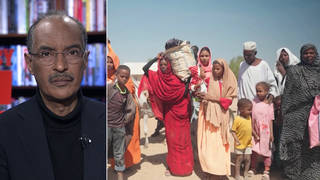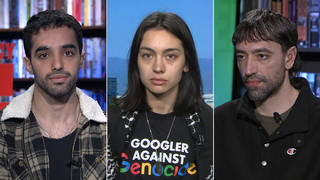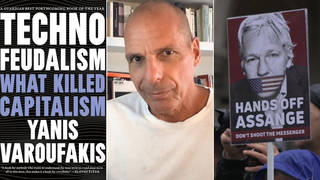
Related
Topics
Guests
- Antonia Juhaszoil and energy investigative journalist.
- Monique Verdincitizen of the United Houma Nation and part of Another Gulf Is Possible, a grassroots environmental group led by women of color.
Despite desperate climate warnings against new fossil fuel development, ExxonMobil is pursuing a massive new oil project in Guyana that is projected to be the corporation’s largest oil production in the world. A new investigation by Antonia Juhasz, a longtime oil and energy investigative reporter, reveals the project will release 125 million metric tons of carbon dioxide per year, turning Guyana from a carbon sink into what she says could be a “carbon bomb” and posing major environmental risks.
More from this Interview
- Part 1: Hurricane Ida Slams Native Communities in Louisiana as New Orleans Loses Electricity & COVID Rages
- Part 2: Hurricane Ida Hits Oil Industry in Black & Native Communities on Louisiana Coast Amid Climate Crisis
- Part 3: Exxon’s Oil Drilling Gamble Off Guyana Coast Could Turn Country from a Carbon Sink to a “Carbon Bomb”
Transcript
AMY GOODMAN: Antonia Juhasz, your recent investigation for The Guardian is titled “Exxon’s oil drilling gamble off Guyana coast 'poses major environmental risk.'” Can you talk about ExxonMobil’s massive new oil project in Guyana, which is thousands of miles away, projected to be the corporation’s largest oil production in the world, coming despite desperate climate warnings against new fossil fuel development, Guyana currently a carbon sink? So, you say it’s at risk of turning into a carbon bomb. And then relate it to what we’re seeing in the Gulf.
ANTONIA JUHASZ: Yeah. So, Exxon has said that it’s committed to helping meet to Paris climate goals of reducing global warming 1.5 degrees Celsius above preindustrial levels. It has said that it is aware of the climate crisis and, you know, is taking steps to reduce things like flaring of methane and to move into a less carbon-intensive model of production. At the same time, it is, through this new project in Guyana, turning a country that was a non-oil producer, you know, right now, into a massive oil producer, with a prediction of 9 billion barrels of oil to be produced in Guyana. And so, this is brand-new development. Exxon moved in in 2015, started production in late 2019. So it’s making this decision now at a time when institutions, including the International Energy Agency, have said, to avert the worst of the climate crisis, there can be no new fossil fuel production. And in the midst of that, in the midst of that consensus emerging, Exxon is going to bring its largest oil production — predicted to be its largest oil production in the world — online in Guyana. So, that is obviously a huge mismatch of rhetoric and reality.
In my article — it’s an article for The Guardian and Floodlight — I found that this production would release 125 million metric tons of carbon dioxide per year from 2025 to at least 2040. That’s the equivalent of 15 coal facilities operating every year annually. But not only — and Exxon is flaring consistently from these operations, even though it said that it would not and it’s not supposed to, and that also releases methane and more carbon-intensive operations.
But in terms of the safety to communities and lessons learned from things like the BP Deepwater Horizon disaster here in the Gulf of Mexico, I had Dr. Robert Bea, who is one of the world’s most renowned experts, at the University of California, Berkeley, and one of the most trusted experts on the BP Deepwater Horizon disaster, many other offshore disasters, formerly worked for Shell, to review 1,000 pages of Exxon’s permits and other submissions to the government of Guyana for its offshore operations there. And these are deepwater, ultra-deepwater operations, very technologically complex, very risky operations off the shore of Guyana. And he said that Exxon’s plans were superficial, were putting forward improbable predictions of what their capacity was to address and put in place the necessary safety mechanisms for operating in this dangerous type of production, and that they were taking — and what another person I interviewed, Dr. Vincent Adams, who is the former head of Guyana’s Environmental Protection Agency, as well as Melinda Janki, an international environmental lawyer from Guyana who wrote many of Guyana’s environmental laws — they both said Guyana completely lacks the capacity to oversee these operations, to be a regulator of these operations.
Those two pieces combined made Dr. Bea very concerned that there is not the safety mechanisms in place here in case there is — very predictable outcome with deepwater drilling — a blowout, like there was in the case of BP Deepwater Horizon, that they don’t have the necessary safety equipment in place, the lessons learned from BP, things like a capping stack, which comes on if there’s a blowout to secure in the pipe; a second relief well, which is how the Deepwater Horizon, you know, only after 150 days, finally actually shut in the Macondo well blowout — and that these are not in place in Guyana, and that he said he is far from comfortable with the safety of these operations, and Exxon should be far from comfortable, as well.
AMY GOODMAN: Well, before we end this part of the discussion, I want to go back to Monique Verdin of the Houma Nation. Your group is called Another Gulf Is Possible. As we begin to see the level of destruction, what is possible?
MONIQUE VERDIN: Well, I mean, the only thing that’s really possible right now is for people to support people as best they can. And from past disasters, we know that, you know, it’s really those who are on the ground who are able to support their community members best and know what they need.
So, we currently have a mutual aid campaign that’s out there, on AnotherGulf.com, where we’re trying to raise funds. We’re planning to deploy a couple of just recovery vehicles in the coming days to try to bring supplies in and to try to support folks who are not going to be able to come home, in whatever ways that we can, whether that means helping them to find housing, food. I mean, everyone is so broken already because of COVID and the situation we’ve been in for the last year and a half. So, we know that folks are already, yeah, at their end of the rope.
And then, also, we’re trying to just — you know, knowing that this is not going away, right? We’re in the climate chaos dance for now until. And so, what kind of equipment can we give to folks so that they can be as resilient as possible in these times on their own? So, we’ve been also deploying these just recovery kits, which include a Big Berkey water filter and a little solar pack, because we know that those two simple items can really be life-saving. So, that’s where we’re at right now. I mean, I think it’s what is our community going to need, and also remembering that this storm is going to pass, but there are other storms that are lining up. You know, last year was really intense, and I fear that this will not be our last storm this season.
AMY GOODMAN: Monique Verdin, we want to thank you so much for being with us, citizen of United Houma Nation, now evacuated to Pensacola, Florida. She’s with the group Another Gulf Is Possible. And Antonia Juhasz, oil and energy investigative journalist, 2020-'21 Bertha fellow, whose recent investigation for The Guardian headlined “Exxon's oil drilling gamble off Guyana coast 'poses major environmental risk.'” We’ll link to it.
Next up, we go to Afghanistan. Stay with us.











Media Options